(Above) Firefighter working to contain forest fire in Northern California (NYTM).

Autumn sunlight streaming through a healthy forest on Planet Earth.
The facts and consequences of global climate crises are awesome, depressing, and frightening in human and planetary terms. Climate Corner reviews timely climate science and news reports and selects a few that elicit a resounding “wow” response, positive or negative. Climate Corner shares a few “wow words and images”, with links, to motivate you to read more.
At a Glance
- After the Summer Climate Corner discussed millimeters of sea level rise, parts per billion of methane, and trillions of US $, this Fall Climate Corner answers why the military spent $5 billion on a natural disaster and is terrified of climate change.
- We then consider why, when, and where humans may soon migrate many hundreds of miles because of a warming planet with increasing climate extremes such as record droughts, violent storms, and devastating wildfires.
- With the Environmental Protection Agency (EPA) announcing the elimination of established methane emission standards, learn how environmental groups and State governments have fought back. An abridged methane overview is included.
Military Worries About Readiness for Climate-Related Disaster Relief.
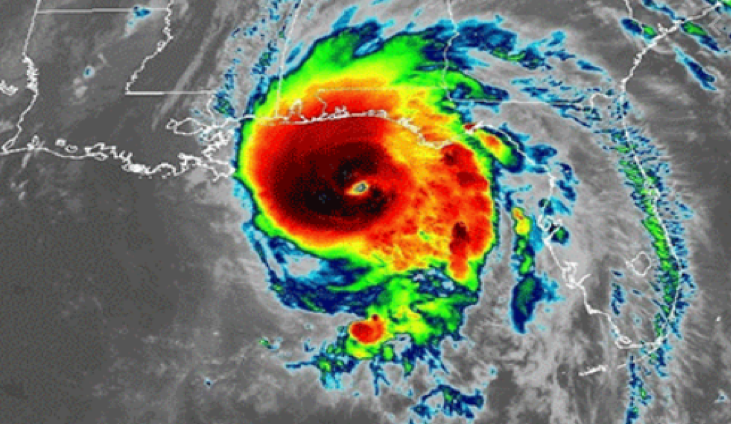
Hurricane Michael nears the Florida Panhandle in 2018 (NOAA).

Damaged hangar at Tyndall Air Force Base (NPR).
“The military is terrified of climate change. It’s done more damage than Iranian missiles”. So reads the title of the September 20, 2020 NBC’s Digital opinion section THINK. It details the incredible $5 billion damage to Tyndall Air Force Base from Hurricane Michael in 2018. The story, and its links, reveal a military worried about maintaining its resources in readiness for climate-related disaster relief during unprecedented storms and wildfires. https://www.nbcnews.com/think/opinion/u-s-military-terrified-climate-change-it-s-done-more-ncna1240484
The current 2020 Atlantic Hurricane season has been historic. Louisiana is still recovering in November from Hurricanes Laura, Delta, and Zeta (CNN). It is only the second time that the Greek alphabet was needed for Atlantic-Basin storm names. Laura was the strongest and Delta the second-strongest storm this year. Delta had the fastest “rapid intensification rate” (time from tropical-depression-to-Category-4 hurricane) ever recorded in the Atlantic-Basin. On October 28, Zeta became the 11thnamed storm to make U. S. landfall in a single season, setting a new record (USATODAY). We know that warmer oceans generate and sustain more intense hurricanes. And, of course, ocean warming is a direct result of greenhouse gases in the troposphere.
Why and When We Flee?
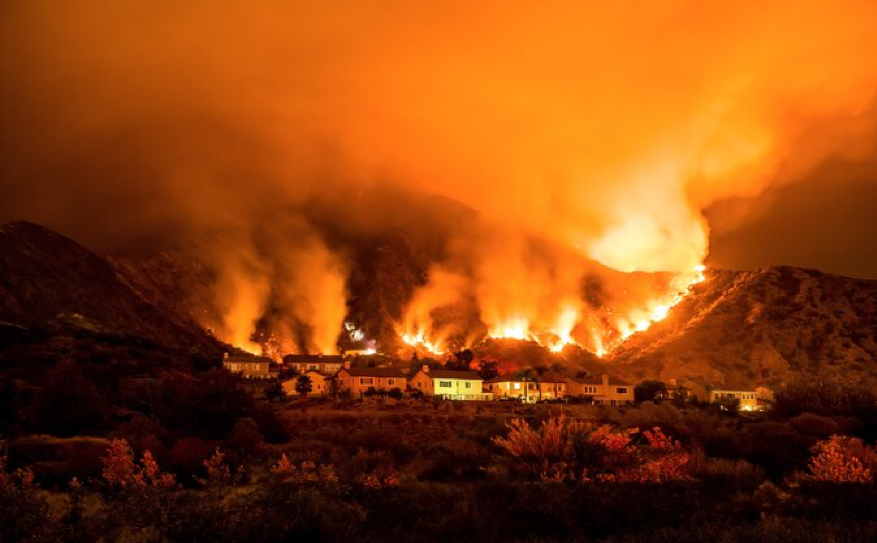
Azusa Ranch 2 fire burned over 4,200 acres during the worst wildfire season in California history (NYT).
The Sunday, September 25, 2020 New York Times Magazine, in partnership with ProPublica and the Pulitzer Center, produced a grim, shocking, public exposé of the devastating consequences of a warming planet on all facets of American life, including massive, near-future, population migrations. https://www.nytimes.com/interactive/2020/09/15/magazine/climate-crisis-migration-america.html
Where Will We Go?
The NY Times Magazine climate-related prophecies for Americans followed the statistical global temperature predictions in the May 2020 Proceedings of the National Academy of Sciences. For thousands of years human populations have mainly concentrated in narrow geographical regions with, surprisingly low, mean annual temperature niches in the 50os Fahrenheit. Assuming unabated climate warming, the predictions for the next 50 years are that the niche will shift geographically more than it has in 6,000 years to higher latitudes, potentially resulting in the migration (displacement) of millions of people.
The Future of the Human Migration
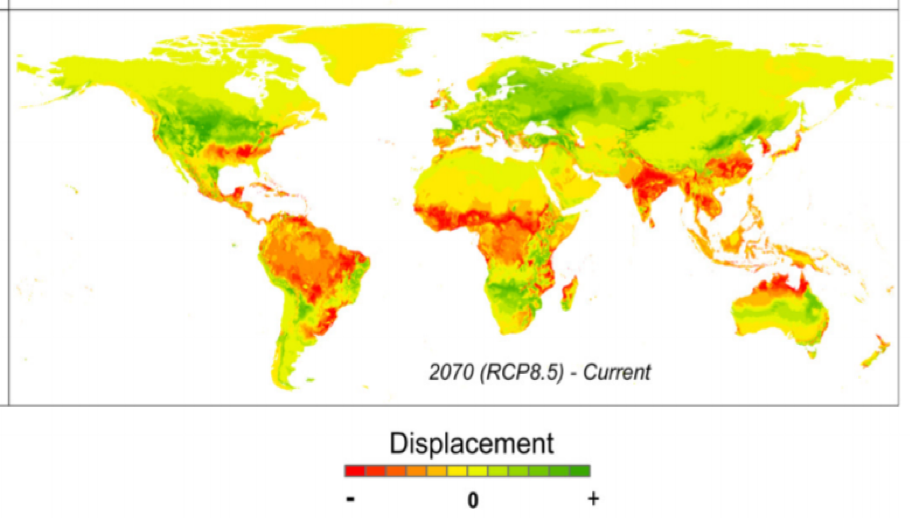
PNAS Appendix Figure S10, bottom right column. Global regions of the geographical change (Displacement) of the human population niche in 2070 relative to now (Current). (Displacement) for the next 50 years expressed as the population difference between a predicted model scenario (2070 RCP8.5) and the distribution now (Current). Yellow areas are regions of zero (0) predicted displacement, or stable population. Red regions (negative displacement) are regions of population decline and green areas (positive displacement) plot regions of population increase. Predicted migration would be from red areas to green areas, e.g., from the southern U. S. Gulf Coast region to the Northern U. S. and Southwestern Canada. https://www.pnas.org/content/pnas/117/21/11350.full.pdf
Follow-up: Methane and the EPA
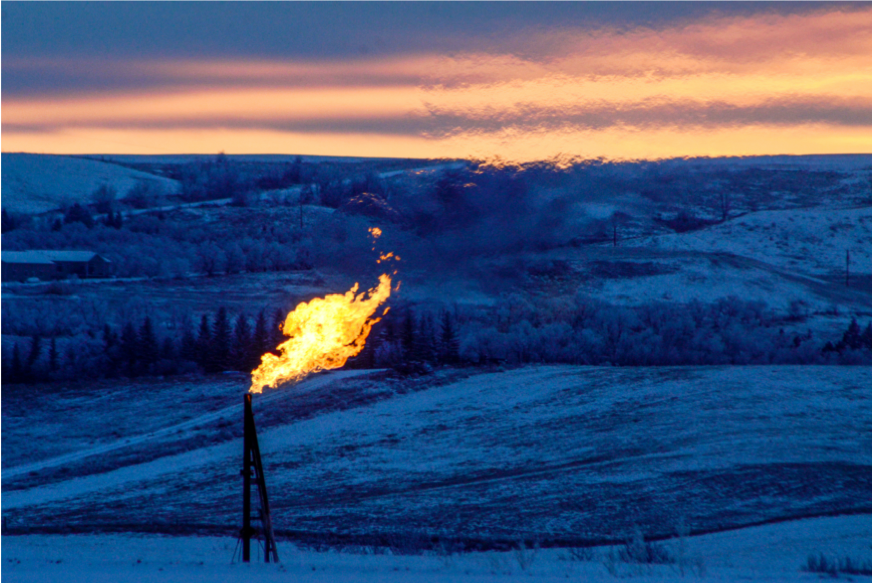
On August 13, 2020 the U.S. Environmental Protection Agency (EPA) moved to rollback Obama-era regulations on methane flaring, leaking, and transport. This was reported to having been done, in part, because EPA data shows that methane leaks from domestic oil and gas wells have been steady over the last decade. This is in complete conflict with the documented largest methane leak in the nation’s history that occurred from 2018 to 2019 as reported in Climate Corner Summer 2020. https://rhg.com/research/the-rollback-of-us-climate-policy/#_ftn1
On September 14, a coalition of 24 states and municipalities filed a lawsuit with the U. S. Circuit Court of the District of Columbia opposing the rescission of the methane rules. Separately, on September 19, the U. S. Court of Appeals for the D. C. Circuit paused the EPA’s rescission order pending review of a request by 10 environmental groups led by the Environmental Defense Fund (EDF) for summary vacatur (reversal) of the order. https://www.naturalgasintel.com/epas-rollback-of-oil-gas-methane-rules-paused-by-court-amid-multiple-lawsuits/
Methane: An Abridged Overview

Methane CH4 molecules vacate sheep.
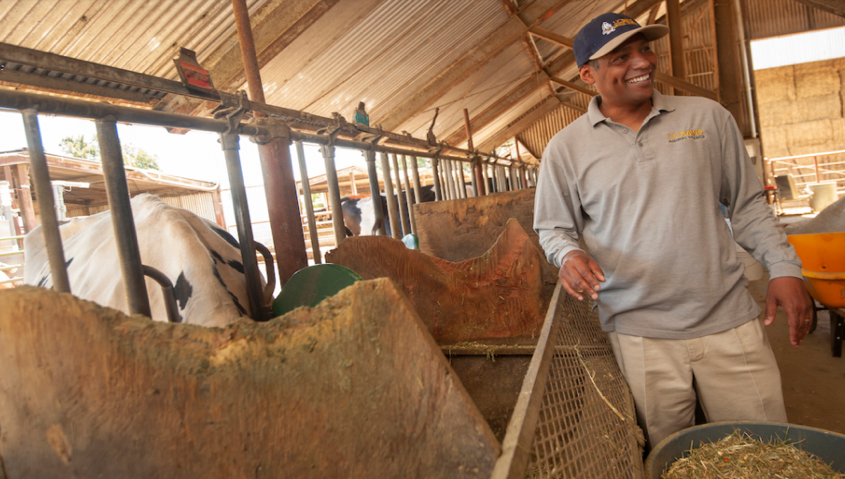
UC Davis Professor Ermias Keberab studies seaweed diet for cows (UCD).
Carbon dioxide is far more abundant in the atmosphere than methane and persists for 1000’s of years so it is the most dominant greenhouse gas. However, methane has a “global warming potential” (GWP) that is 72–84 times more than carbon dioxide in a 20-year horizon and 23–25 times more on a 100-year time frame. (GWP compares greenhouse energy per unit mass.) Methane emissions from ruminant animals such as beef and dairy cattle, sheep, and goats as burps and expelled gas are nearly as large as those from fossil fuels (natural gas is about 90% methane). So, the attached “sheep cartoon” has it right by showing the CH4 methane tetrahedral molecules flying off into the atmosphere. Different chemical structures, e.g. CH4, H2O, CO2, absorb and emit specific frequencies of infrared radiation (heat) that are responsible for greenhouse warming or cooling. Reducing ruminant sources of CH4 are mostly nutritional, e. g., feeding cattle more grass, hay, seaweed, and asking humans to eat less beef. Since California now requires dairy farmers to cut methane emissions by 40 % by 2030, the University of California at Davis is studying the seaweed option. https://www.ucdavis.edu/news/can-seaweed-cut-methane-emissions-dairy-farms#:~:text=The%20UC%20Davis%20project%20is%20first%20in%20the,gas%20emissions%20from%20California%E2%80%99s%201.8%20million%20dairy%20cows.
For the latest on methane emissions see the data-rich June 2020 report from Stanford University: https://iopscience.iop.org/article/10.1088/1748-9326/ab9ed2
To study how atmospheric warming works, Climate Corner recommends the American Chemical Society’s Climate Science Tool Kit: https://www.acs.org/content/acs/en/climatescience/getting-started.html
Lead author of Climate Corner is George Jiracek, Navy veteran and Professor Emeritus at San Diego State University (Geophysics). To comment and/or to suggest contributions to SDVFP Climate Corner please contact treasurer@sdvfp.org.








